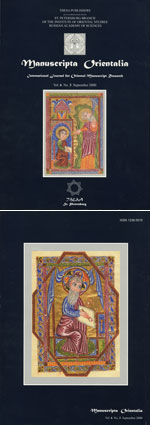|
|
| |

|

|
Vorobyova-Desyatovskaya M. A Sanskrit Manuscript on Birch-Bark from Bairam-Ali: II. Avadānas and Jātakas (Part 1) // Manuscripta Orientalia. Vol. 6. No. 3. September 2000. P. 23—32.
We have already described the discovery of a Buddhist manuscript on birch-bark removed from the earth not far from the city of Bairam-Ali (Merv oasis, Turkmenia). We have also published a general description of the manuscript and one of the texts which belongs to the Vinaya section of the Buddhist Tripitaka. This text is a completed work and has a colophon, thanks to which we were able to establish that the manuscript contains an excerpt from the Sanskrit Canon of the Sarvāstivādins. The other part of the manuscript is a work which lacks both beginning and end. This part consists of 68 full folios and several fragments. The full folios are 19.0 x 5.0 cm and contain five lines of text on each side. All of the folios were copied in the same hand, which differs from the rest of the manuscript. The hand is close to calligraphic and neat; according to L. Sander's classification, it belongs to the Turkestan Gupta type, and can be dated to the fifth century A.D.
In content, the manuscript consists of a selection of avadāna and jātaka stories. In the text itself, they are sometimes termed only avadāns; the term jātaka does not occur once. The nature of the extant text suggests that it did not contain a full copy of the work at hand, but rather a part of it written in conspectual form. It is possible that the avadānas and jātakas were copied from the Sutras section and the Vinaya Canon of the Sarvāstivādins. In our view, the conspectual nature of the exposition and the arrangement of the text in the manuscript indicate that the text was written down for memorizing and was used as illustrative material during proselytizing. Divergences from the Buddhist tradition of the Theravādins and Mūlasarvāstivādins and the ideological affiliation of the stories selected from the Canon reveal a connection with the early teaching of Sravakāyāna. Certain gāthās and aphorisms may have been recorded from memory or from the words of the teacher.
Before the manuscript was shut into a pitcher, its folios were shuffled in such a way that the collection of avadānas and jātakas was distributed in various parts of the manuscript. As has already been noted, 68 pages of this work were discovered among the 150 folios of the manuscript. The bulk of them — 41 folios — were at the end of the sheaf, 25 folios in the middle, and 2 in the section with excerpts from sutras. Nearly all folios have brāhmï numerical pagination on the left margin, running inclusively from 5 to 69. The first two folios lack pagination; judging by content, they are fols. 3 and 4.
The original pagination is faulty in two places: (i) two folios are numbered fol. 15, while the second of them should apparently have been 18; (ii) after folio 29, there is a doubly paginated folio: 28 and 30. In the remainder, the numeration is accurate.
Fragments were also preserved among folios of unrelated content. They will be published in the order in which they were discovered during restoration…
К содержанию выпуска...
 PDF-файлы PDF-файлы
Полный текст статьи
Ключевые слова
аваданы
джатаки
коллекция ИВР РАН: издания
коллекция ИВР РАН: переводы
коллекция ИВР РАН: факсимиле
рукописи санскритские
фонд сериндийский
Центральная Азия
|
|
|
|
Случайная новость: Объявления |
|
25–26 ноября 2024 г. в ИВР РАН пройдут ХVIII Всероссийские востоковедные чтения памяти О.О. Розенберга. |
|
Подробнее...
|
|
|
|
|

